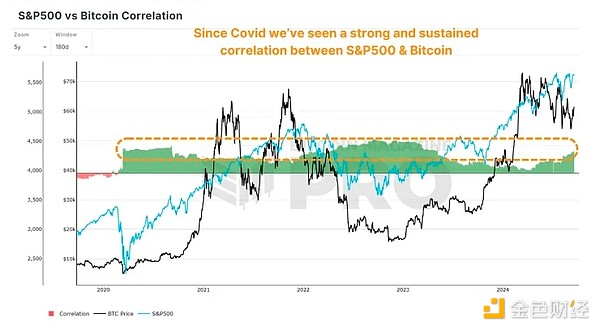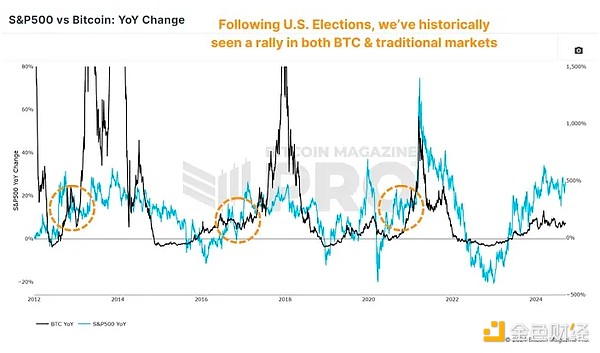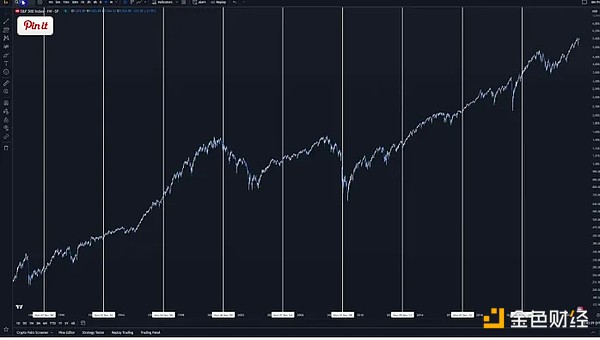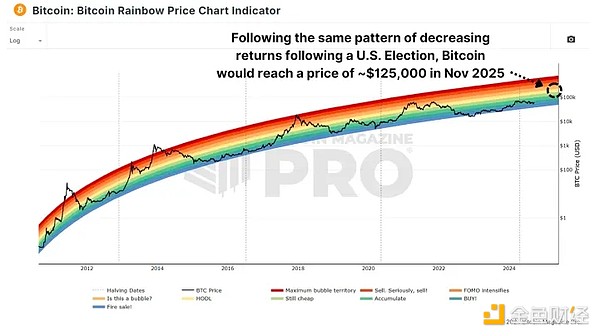Author: Matt Crosby, Bitcoin Magazine; Translator: Deng Tong, Golden Finance
With the US presidential election approaching, it is worth examining how past elections have affected the price of Bitcoin. Historically, the US stock market has shown clear trends during elections. Given Bitcoin's correlation with stocks and, most notably, the S&P 500, these trends can provide us with a reference for what may happen next.
S&P 500 Correlation
Bitcoin and the S&P 500 have historically maintained a strong correlation, especially during BTC's bull cycles and periods of risk-on sentiment across traditional markets.As Bitcoin matures and "decouples" from stocks and its narrative as a speculative asset, this phenomenon may end. However, there is no evidence yet to suggest that this is the case.

Figure 1: Bitcoin's 180-day correlation with the S&P 500 over the past five years.
Post-election Outperformance
The S&P 500 typically reacts positively after U.S. presidential elections. This pattern has been consistent over the past few decades, with stocks typically seeing a big rally in the year following an election. In the S&P 500 vs. Bitcoin year-over-year chart, we can see when the election occurred (orange circles), and the price action of BTC (black line) and the S&P 500 (blue line) in the months that followed.

Figure 2: Bitcoin and the S&P 500 have seen excess returns in the year following the election.
2012 Election: In November 2012, the S&P 500 was up 11% year-over-year. A year later, that gain had surged to around 32%, reflecting a strong post-election market rally.
2016 Election: In November 2016, the S&P 500 was up around 7% year-over-year. A year later, the index was up about 22%, again showing a big post-election surge.
2020 Election: 2020 continues the pattern. In November 2020, the S&P 500 was up about 17-18%; by the following year, it had climbed to nearly 29%.
A recent phenomenon?
This isn’t limited to just the three elections in Bitcoin’s existence. For a larger data set, we can look at S&P 500 returns over the past four decades, or ten elections. Only one year has had negative returns in the twelve months following Election Day (2000, the dot-com crash).

Figure 3: The S&P 500 has mostly performed well after Election Day.
Historical data suggests that a win for either the Republican or Democratic party does not have a significant impact on these positive market trends. Instead, the upward momentum is more about resolving uncertainty and boosting investor confidence.
How Bitcoin Will React This Time
With the 2024 U.S. presidential election approaching, it is easy to speculate on Bitcoin's potential performance. If the historical trend holds, we could see a significant increase in price. For example:
If we experience the same percentage gain as 2012 in the 365 days following the election, the price of Bitcoin could rise to $1,000,000 or more. If we experience the same scenario as the 2016 election, we could climb to around $500,000, while something similar to 2020 could see $250,000 in BTC.
It’s worth noting that each occurrence resulted in returns dropping by about 50% each time, so perhaps $125,000 is a realistic target for November 2025, especially if that price and data align with the middle band of the rainbow price chart. It’s also worth noting that in all of these cycles, Bitcoin has actually experienced higher cycle peak gains!

Figure 4: Rainbow price chart consistent with post-election price targets based on historical patterns.
Conclusion
The data suggests that the period following the U.S. presidential election is bullish for both stocks and Bitcoin. With the next election less than two months away, Bitcoin investors may have reason to be optimistic about the coming months.
 Weatherly
Weatherly







